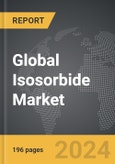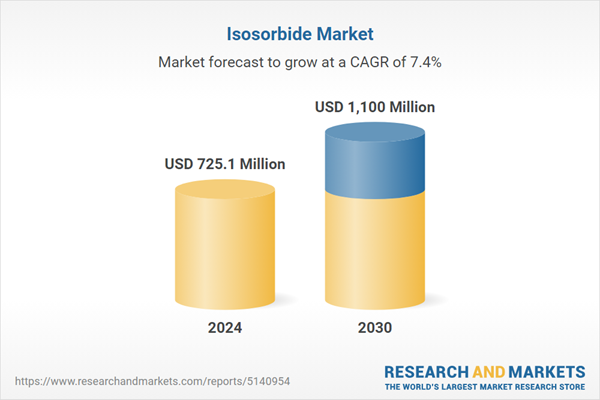The global market for Isosorbide was estimated at US$725.1 Million in 2024 and is projected to reach US$1.1 Billion by 2030, growing at a CAGR of 7.4% from 2024 to 2030. This comprehensive report provides an in-depth analysis of market trends, drivers, and forecasts, helping you make informed business decisions. The report includes the most recent global tariff developments and how they impact the Isosorbide market.
Global Isosorbide Market - Key Trends & Drivers Summarized
Why Is Isosorbide Gaining Traction as a Sustainable and High-Performance Chemical?
Isosorbide, a bio-based platform chemical derived from sorbitol, is rapidly emerging as a key player in sustainable chemistry, offering a high-performance alternative to petroleum-based compounds. With the increasing emphasis on reducing carbon footprints and transitioning to greener materials, isosorbide has found growing applications in polymers, resins, pharmaceuticals, and personal care formulations. In the plastics industry, its ability to enhance thermal stability, rigidity, and biodegradability has positioned it as a critical ingredient in the development of bio-based polycarbonates and polyesters. Additionally, the demand for bisphenol A (BPA)-free plastics has surged, with isosorbide serving as an essential monomer for producing safe and high-performance alternatives. In the pharmaceutical sector, its role as a precursor in the synthesis of isosorbide mononitrate and isosorbide dinitrate for cardiovascular treatments has further reinforced its market significance. The cosmetics and personal care industry is also witnessing increased adoption, as isosorbide-derived emulsifiers and humectants provide improved stability and skin-friendly properties. With regulatory bodies imposing stringent guidelines on petroleum-based chemicals, industries are actively exploring bio-based alternatives, accelerating the global demand for isosorbide-based solutions.How Are Technological Innovations Transforming Isosorbide Production and Applications?
Advancements in bio-refinery technologies and catalytic conversion processes have significantly improved the efficiency and scalability of isosorbide production, enabling manufacturers to meet the rising industrial demand. The shift toward greener production methodologies has led to the development of cost-effective, high-yield catalytic processes that enhance purity levels and reduce unwanted byproducts. Additionally, improvements in enzymatic conversion techniques have enabled the efficient transformation of starch-based feedstocks into sorbitol and, subsequently, into isosorbide with reduced energy consumption. The growing focus on enhancing the performance of isosorbide-based polymers has also driven extensive research into copolymerization techniques, enabling the development of high-strength, heat-resistant, and transparent bio-plastics. Recent innovations in isosorbide-based epoxy resins have further opened new avenues in industrial coatings, adhesives, and automotive applications, where superior durability and environmental compliance are key requirements. Moreover, the ongoing advancements in functionalization strategies have expanded the utility of isosorbide in biomedical applications, including drug delivery systems and bioresorbable implants. As industries continue to prioritize sustainability and performance, technological progress in isosorbide synthesis and application development is expected to play a pivotal role in market expansion.Why Is the Demand for Isosorbide Surging Across Diverse Industrial Sectors?
The widespread adoption of isosorbide across multiple industries is primarily driven by its eco-friendly nature, regulatory compliance, and superior material properties. In the packaging industry, the increasing consumer preference for sustainable materials has fueled demand for isosorbide-based bio-PET and bio-polycarbonates, which offer enhanced barrier properties and recyclability. The automotive sector is also leveraging isosorbide-derived polymers to develop lightweight, impact-resistant components that contribute to improved fuel efficiency and reduced emissions. Additionally, the surge in green building initiatives has led to the incorporation of isosorbide-based resins in flooring, insulation, and coatings, providing enhanced durability while minimizing environmental impact. In the electronics industry, the transition toward halogen-free flame retardants has propelled the use of isosorbide-based polycarbonates, which offer excellent heat resistance and electrical insulation. The pharmaceutical and medical device sectors have also embraced isosorbide for its biocompatibility and stability, leading to its application in controlled drug release formulations and medical-grade polymers. Furthermore, the food and beverage sector has begun integrating isosorbide-derived ingredients into packaging and processing applications, reducing dependency on petrochemical-based materials. As global sustainability goals continue to shape industry strategies, the market demand for isosorbide-based alternatives is expected to witness exponential growth across diverse end-use segments.What Are the Key Factors Driving the Growth of the Isosorbide Market?
The growth in the isosorbide market is driven by several factors, including the increasing shift toward bio-based chemicals, regulatory restrictions on petroleum-derived materials, and technological advancements in polymer science. The rising demand for sustainable and non-toxic plastics has significantly fueled the adoption of isosorbide-based polycarbonates and polyesters, particularly in the consumer goods, packaging, and automotive industries. Stringent environmental regulations, including bans on BPA and other hazardous petrochemicals, have further accelerated the transition toward bio-based alternatives, creating substantial market opportunities for isosorbide producers. Additionally, the rapid expansion of biopolymer research and investments in green chemistry innovations have strengthened the commercial viability of isosorbide-based materials, improving their competitiveness against conventional plastics. The growing awareness of circular economy principles has also contributed to increased adoption, as industries seek recyclable and compostable alternatives to reduce plastic waste. Furthermore, the rising incorporation of isosorbide in high-value applications, such as biomedical devices, smart coatings, and high-performance adhesives, has diversified its market scope, driving new revenue streams for manufacturers. With continued investments in process optimization, feedstock diversification, and strategic partnerships, the isosorbide market is poised for sustained growth, redefining the landscape of sustainable chemical solutions in the years ahead.SCOPE OF STUDY:
The report analyzes the Isosorbide market in terms of units by the following Segments, and Geographic Regions/Countries:- Segments: Application (PEIT, Polycarbonate, Polyurethane, Polyester Polyisosorbide, Isosorbide Diesters, Other Applications); End-Use (Resins & Polymers, Additives, Other End-Uses)
- Geographic Regions/Countries: World; United States; Canada; Japan; China; Europe (France; Germany; Italy; United Kingdom; Spain; Russia; and Rest of Europe); Asia-Pacific (Australia; India; South Korea; and Rest of Asia-Pacific); Latin America (Argentina; Brazil; Mexico; and Rest of Latin America); Middle East (Iran; Israel; Saudi Arabia; United Arab Emirates; and Rest of Middle East); and Africa.
Key Insights:
- Market Growth: Understand the significant growth trajectory of the PEIT segment, which is expected to reach US$439.5 Million by 2030 with a CAGR of a 9.1%. The Polycarbonate segment is also set to grow at 6.1% CAGR over the analysis period.
- Regional Analysis: Gain insights into the U.S. market, valued at $186.8 Million in 2024, and China, forecasted to grow at an impressive 11.3% CAGR to reach $279.9 Million by 2030. Discover growth trends in other key regions, including Japan, Canada, Germany, and the Asia-Pacific.
Why You Should Buy This Report:
- Detailed Market Analysis: Access a thorough analysis of the Global Isosorbide Market, covering all major geographic regions and market segments.
- Competitive Insights: Get an overview of the competitive landscape, including the market presence of major players across different geographies.
- Future Trends and Drivers: Understand the key trends and drivers shaping the future of the Global Isosorbide Market.
- Actionable Insights: Benefit from actionable insights that can help you identify new revenue opportunities and make strategic business decisions.
Key Questions Answered:
- How is the Global Isosorbide Market expected to evolve by 2030?
- What are the main drivers and restraints affecting the market?
- Which market segments will grow the most over the forecast period?
- How will market shares for different regions and segments change by 2030?
- Who are the leading players in the market, and what are their prospects?
Report Features:
- Comprehensive Market Data: Independent analysis of annual sales and market forecasts in US$ Million from 2024 to 2030.
- In-Depth Regional Analysis: Detailed insights into key markets, including the U.S., China, Japan, Canada, Europe, Asia-Pacific, Latin America, Middle East, and Africa.
- Company Profiles: Coverage of players such as Archer Daniels Midland Company, Cargill, Inc., JP Laboratories Pvt. Ltd., Mitsubishi Chemical Corporation, Novaphene and more.
- Complimentary Updates: Receive free report updates for one year to keep you informed of the latest market developments.
Some of the 46 companies featured in this Isosorbide market report include:
- Archer Daniels Midland Company
- Cargill, Inc.
- JP Laboratories Pvt. Ltd.
- Mitsubishi Chemical Corporation
- Novaphene
- PAR Pharmaceutical Companies, Inc.
- Roquette Freres S.A.
- SK Chemicals Co., Ltd.
This edition integrates the latest global trade and economic shifts as of June 2025 into comprehensive market analysis. Key updates include:
- Tariff and Trade Impact: Insights into global tariff negotiations across 180+ countries, with analysis of supply chain turbulence, sourcing disruptions, and geographic realignment. Special focus on 2025 as a pivotal year for trade tensions, including updated perspectives on the Trump-era tariffs.
- Adjusted Forecasts and Analytics: Revised global and regional market forecasts through 2030, incorporating tariff effects, economic uncertainty, and structural changes in globalization. Includes segmentation by product, technology, type, material, distribution channel, application, and end-use, with historical analysis since 2015.
- Strategic Market Dynamics: Evaluation of revised market prospects, regional outlooks, and key economic indicators such as population and urbanization trends.
- Innovation & Technology Trends: Latest developments in product and process innovation, emerging technologies, and key industry drivers shaping the competitive landscape.
- Competitive Intelligence: Updated global market share estimates for 2025, competitive positioning of major players (Strong/Active/Niche/Trivial), and refined focus on leading global brands and core players.
- Expert Insight & Commentary: Strategic analysis from economists, trade experts, and domain specialists to contextualize market shifts and identify emerging opportunities.
- Complimentary Update: Buyers receive a free July 2025 update with finalized tariff impacts, new trade agreement effects, revised projections, and expanded country-level coverage.
Table of Contents
I. METHODOLOGYII. EXECUTIVE SUMMARY2. FOCUS ON SELECT PLAYERSIII. MARKET ANALYSISSOUTH KOREAREST OF ASIA-PACIFICARGENTINABRAZILMEXICOREST OF LATIN AMERICAIRANISRAELSAUDI ARABIAUNITED ARAB EMIRATESREST OF MIDDLE EASTIV. COMPETITION
1. MARKET OVERVIEW
3. MARKET TRENDS & DRIVERS
4. GLOBAL MARKET PERSPECTIVE
UNITED STATES
CANADA
JAPAN
CHINA
EUROPE
FRANCE
GERMANY
ITALY
UNITED KINGDOM
SPAIN
RUSSIA
REST OF EUROPE
ASIA-PACIFIC
AUSTRALIA
INDIA
LATIN AMERICA
MIDDLE EAST
AFRICA
Companies Mentioned (Partial List)
A selection of companies mentioned in this report includes, but is not limited to:
- Archer Daniels Midland Company
- Cargill, Inc.
- JP Laboratories Pvt. Ltd.
- Mitsubishi Chemical Corporation
- Novaphene
- PAR Pharmaceutical Companies, Inc.
- Roquette Freres S.A.
- SK Chemicals Co., Ltd.
Table Information
| Report Attribute | Details |
|---|---|
| No. of Pages | 196 |
| Published | July 2025 |
| Forecast Period | 2024 - 2030 |
| Estimated Market Value ( USD | $ 725.1 Million |
| Forecasted Market Value ( USD | $ 1100 Million |
| Compound Annual Growth Rate | 7.4% |
| Regions Covered | Global |









